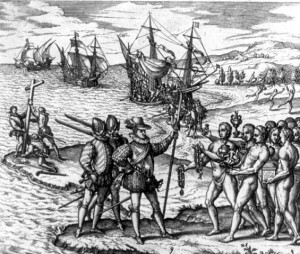As children, most of what we learned about the Native American population of the Americas was based on what colonists and conquerors saw after they had already left their mark on the land and people. But, what was life in the Americas like before Europeans arrived? And, what happened in the century after Columbus landed?
1491 by Charles Mann is a great place to start learning more about the rich and varied cultures that existed in North and South America. Contrary to what many of us were taught, the Americas were not sparsely populated, untouched wilderness. There is evidence that the dense, impenetrable Amazon jungle European explorers encountered had once had large areas of cultivated farm land.
In his next book, 1493, Mann examines the Columbian Exchange and the ways that both the old and new worlds changed in the century after Columbus. Plants, animals, human beings, technologies and many diseases also made the journey between the old and the new worlds. Tomatoes, potatoes, chocolate, tobacco and syphilis made the journey to the old world, while horses, coffee, smallpox and African slaves were taken to the new world. According to some estimates, up to 90 percent of the Native population of the Americas died from diseases brought from the old world to which they had no immunity.
Tony Horowitz also explores the century after Columbus' arrival in A Voyage Long and Strange. More than a hundred years had passed between Columbus' arrival on American shores and the landing of the Mayflower, and that century was a busy one. When the Pilgrims arrived in America, they met Tisquantum/Squanto, a member of the Pawtuxet tribe who had already made the journey between Europe and America several times, usually unwillingly, and then served as translator between the Pilgrims and the local Wampanoag tribe. The Pilgrims had settled on the land formerly inhabited by the Pawtuxet and could only do so because the entire tribe had been wiped out by disease while Tisquantum was away. He was the last member of his tribe.
In River of Darkness, Buddy Levy moves the focus to the Amazon jungle. After plundering Inca lands, conquistadors Francisco Orellano and Gonzalo Pizarro set off in search of El Dorado. Instead of finding the mythical city, the two men got separated and Orellano and his men got lost in the jungle, suffered from starvation, were attacked by natives and had many, many other unpleasant experiences. Eventually, he made his way to the Atlantic, and along the way got a glimpse of life in the Amazonian jungle before it all changed forever.
If you would prefer a primary source, you won't do any better than Bartolome de las Casas's A Short Account of the Destruction of the Indies. Written by the Spanish friar for the king of Spain, it was meant to convince the Spaniards that their treatment of the native population was horrific and inhumane. His efforts were successful, and Native slavery was abolished. Unfortunately, African slaves quickly took their place. Nevertheless, this is a chilling account of what life was like in America in the years after Columbus.




Add a comment to: The Americas Before the Mayflower